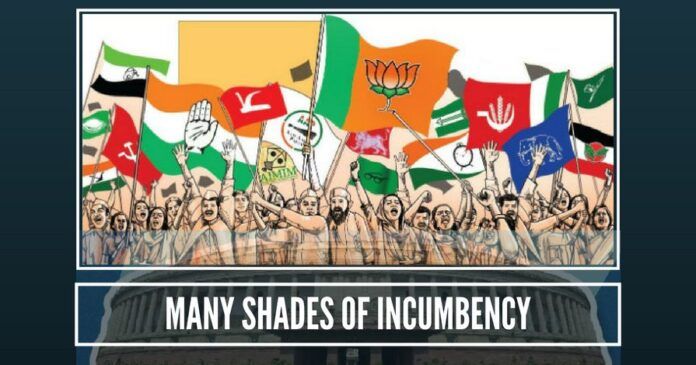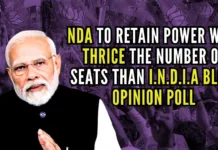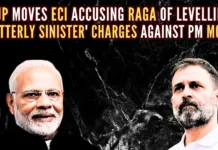
The incumbency factor is likely to play an important role in the upcoming State and Lok Sabha elections
Among the weapons that opposition parties are hoping to use to end the Bharatiya Janata Party rule at the Centre, and earlier in some States, is that of anti-incumbency. The BJP’s rivals are expecting the anti-incumbency plank to provide the tailwind to their oust-BJP campaign. They reckon that the old saying, “Winning power is one thing, retaining it is another”, will work in their favour. There is no doubting the potency of anti-incumbency, but does it necessarily work? Also, is there not the pro-incumbency factor to be considered?
The UPA regime collapsed not just because it had been around for ten years and the people, for this reason alone, wanted a change; it lost the mandate because of cases of high-profile corruption
A quick look at examples in the recent decades offers a mixed answer. The Congress-led UPA Government collapsed after a ten-year run, crippled by the disadvantages of anti-incumbency. The factor also claimed Congress regimes in Haryana, Delhi and Rajasthan. On the other hand, anti-incumbency did not work in Gujarat, where the people have been mandating the BJP to govern in every State election since 2002; nor did it manage to dislodge the party’s Governments in Madhya Pradesh and Chattisgarh. Anti-incumbency hasn’t worked in Odisha, where the Biju Janata Dal registered wins, or in West Bengal where the Trinamool Congress stormed back to power. Interestingly, the factor had failed to click against the Congress-led UPA in 2009, when the combine retained power for a second consecutive five-year term.
The essence of anti-incumbency lies in the fact that those in power, while having achievements, also have failures. In electoral contests, the tussle between the two inevitably happens and the winner decides the outcome. It is for the ruling party to ensure that the positives dominate the narrative, and for the opposition to bring the negatives to the fore. Psychologically speaking, voters tend to be led more by failures than successes of their rulers. Except when the narrative of positives is so dominant that it smothers the failures. This is where the Modi Government needs to concentrate: it will have to push its achievements aggressively enough to counter perceptions of a failed regime. In a way, anti-incumbency is like ageing; it cannot be halted but can be managed.
But the mere fact that a Government will inevitably have some negatives against it, despite its best efforts, is not sufficient for anti-incumbency to make a mark. It must be accompanied by a resurgence of other factors. For instance, the UPA regime collapsed not just because it had been around for ten years and the people, for this reason alone, wanted a change; it lost the mandate because of cases of high-profile corruption and the general policy paralysis that had set into governance. The Atal Bihari Vajpayee-led NDA regime lost power in 2004, after just one full term, not so much because of anti-incumbency but the dissatisfaction in rural India, where the public felt that the India Shining campaign had sought to gloss over its distress.
The one situation where the incumbency factor, either way, becomes entirely immaterial is when an external situation develops: Sympathy factor due to a tragic incident, for example
Is there any such dominant disaffection with the Modi Government? It can be argued that rural distress could return yet again to torment this NDA Government too. But it’s also true that the regime has put in place a number of measures to address the problem — from a more comprehensive farm insurance to the recent massive hike in minimum support prices for a variety of crops to personal insurance to the soon-to-be-launched health insurance coverage which will benefit, among others, the marginalised in villages. An early indication of which way the wind is blowing will be had when the results of the Assembly elections (to be held later this year in the States of Madhya Pradesh, Rajasthan and Chhattisgarh), are out. Incidentally, all these States are BJP-ruled, and the anti-incumbency factor is being invoked there.
It is also possible that we may be reading the anti-incumbency factor where it justifiably should not be considered that important. For instance, post-2014, the BJP has registered significant wins in several important State polls. The last Lok Sabha election itself saw the BJP sweep seats in these States. Here, the incumbency factor may be redundant, because there is another factor to be considered: That of saturation. The BJP, with its allies, won 73 of the 80 Lok Sabha seats in Uttar Pradesh; nearly 80 per cent of the constituencies in Bihar; and all in Gujarat and Rajasthan. There is indeed little scope for the party to beat that performance and, therefore, a downfall in the numbers is widely expected. The best that the party can do is to retain those numbers — and that is difficult enough to be close to being impossible.
Local factors, far removed from anti-incumbency, can play an important role. In the case of Uttar Pradesh, the coming together of two regional parties — the Bahujan Samaj Party and the Samajwadi Party — offers a challenge to the BJP in terms of electoral mathematics. In Bihar, it would be the Rashtriya Janata Dal-Congress combine.
The one situation where the incumbency factor, either way, becomes entirely immaterial is when an external situation develops: Sympathy factor due to a tragic incident, for example. Rajiv Gandhi rode to power with a three-fourths majority following the assassination of Indira Gandhi. The Emergency was another instance of an external factor that decimated the Indira Gandhi Government.
No such external element exists as of now. Thus, the incumbency factor is likely to play an important role in the coming State and Lok Sabha elections. It remains to be seen which party can better manage this mercurial element.
Note:
1. The views expressed here are those of the author and do not necessarily represent or reflect the views of PGurus.










